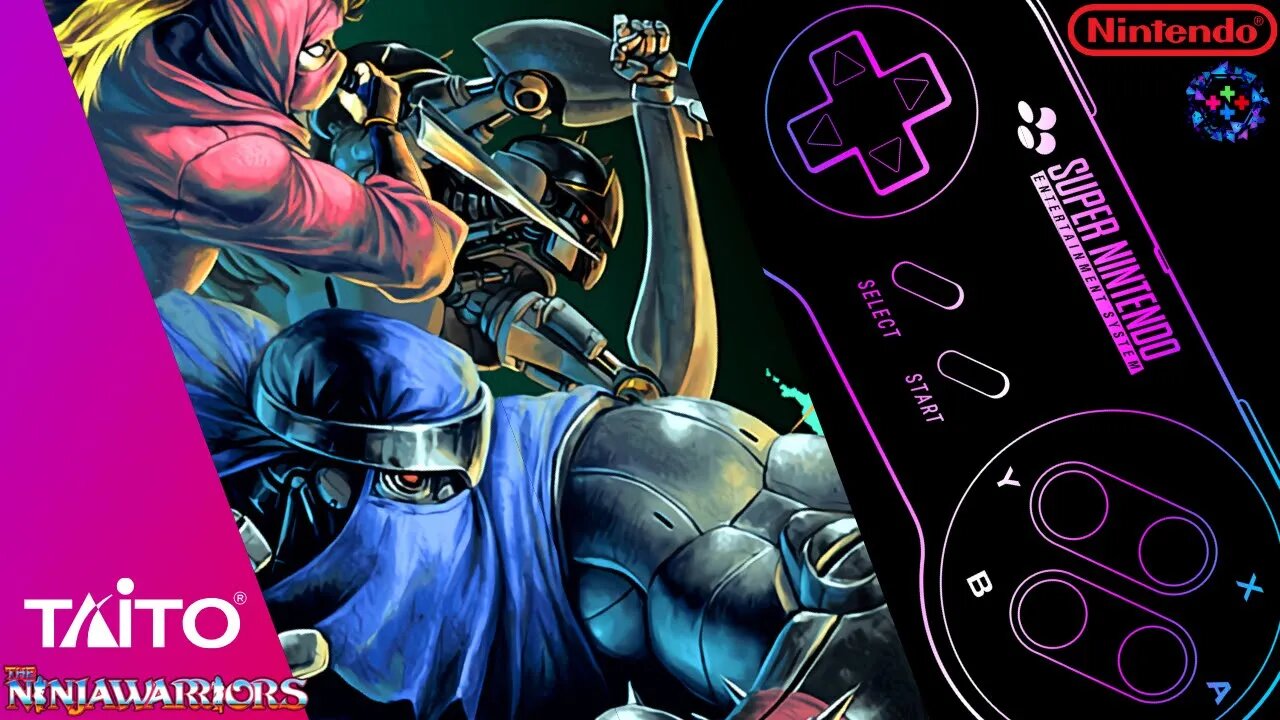Premium Only Content

The Ninja Warriors Once Again / Ninja Warriors: The New Generation / ザ・ニンジャウォーリアーズアゲイン
uper Nintendo Entertainment System and published by Taito in Japan and North America in 1994 and by Titus in Europe in 1995. It is a follow-up to Taito's 1987 arcade game of the same title, and shares similar gameplay. The player can choose between playing as one of three ninja androids, each with different attributes and a unique set of moves including jumps, dashes, throws, and other attacks. The game was developed by the same team at Natsume that later developed Wild Guns (1994).
The game was generally well received by critics. They compared the quality of The Ninja Warriors to Neo Geo and arcade games, and the tight controls and vibrant graphics were universally praised. Reviewers disagreed on the quality of several aspects including the difficulty, sound quality, and how well the game distinguished itself among the myriad of beat 'em up games. An enhanced remaster titled The Ninja Saviors: Return of the Warriors[b] was released in 2019.
Gameplay
Kunoichi kicking an enemy after jumping in the air (Japanese version)
The Ninja Warriors is a beat 'em up game that plays in a side-scrolling manner similar to the 1987 arcade version. The player can choose to play as one of three androids with ninja skills: the slow but powerful "Ninja" armed with a nunchaku, the quick but weak "Kamaitachi" with sickles on his arms, or the balanced "Kunoichi" who wields knives and swords. Per the story, the androids were built by a rebel faction to help them overthrow the tyrant Banglar ruling over their nation. After a sudden attack by Banglar's forces, the rebels had to release the androids to fight, untested.
The player can move along a single plane, with the stages typically going in a linear direction and ending with a boss. Each character has a different set of moves which include speed dashes, jumps, grabs, blocks, and a variety of attack moves. There is a power meter that increases slowly with time that, when full, lets the player trigger a powerful attack that damages all enemies on the screen. The meter drains completely if the player is knocked to the ground.[5] Some items, such as motorcycles and large safes, can be picked up and tossed at enemies. The environments occasionally introduce hazards that can hurt the player as well as enemies, such as mine fields or armed helicopters. The Ninja Warriors has eight stages and unlimited continues. The player character can be changed when using a continue.
Plot
In a dystopian future, the world is dominated by a dictatorial regime ruled by a dwarfish mutant-cyborg man who calls himself "Banglar the Tyrant", who commands an army of brainwashed human soldiers, vicious mutants and non-sentient combat robots. For years, he has ruled the global superpower unchallenged, until a rebel army rises up against him, led by a human named Mulk.
Unable to defeat Banglar and his mutant armies using conventional weapons and fearing the World Government's forces are closing in on them, Mulk's rebel army decides to make one last effort to overthrow Banglar by sending a trio of self-aware combat androids styled after Japanese ninja to assassinate him.
In the end, the androids manage to reach Banglar's fortress, fighting through his army and ultimately killing Banglar himself; as a safety measure, explosives carried within the androids' bodies then detonate, both assuring Banglar's death and eliminating any possible threat to the new regime posed by the powerful androids' still experimental programming. Several months later, Mulk becomes the new President of the World Government. The development of autonomous combat androids continues under Mulk, soon making his military far stronger than Banglar's old forces, and Mulk ends up just as much of a tyrant as the fallen Banglar.
Development and release
The Ninja Warriors was developed by Natsume, specifically the same team that later developed Wild Guns (1994). The team consisted of three core members: game designer and artist Shunichi Taniguchi, programmer Toshiyasu Miyabe, and composer Hiroyuki Iwatsuki. Gaming journalists have deemed it both a remake and sequel of the 1987 arcade original from Taito. The original game was one of Taito's most popular arcade games and set a standard for beat 'em ups.
The game was first released on January 28, 1994, in Japan, published by Taito as The Ninja Warriors Again.[c] Taito localized the game for a release in North America around February that same year, and Titus published the game in Europe in April 1995.
Developer(s) Natsume
Publisher(s)
JP/NA: Taito
EU: Titus
Designer(s) Shunichi Taniguchi
Programmer(s) Toshiyasu Miyabe
Artist(s)
Shunichi Taniguchi
Takashi Shinpo
Shinya Wada
Composer(s) Hiroyuki Iwatsuki
Platform(s) Super NES
Release
JP: January 28, 1994
NA: February 1994
EU: April 1995
Genre(s) Beat 'em up
Mode(s) Single-player
#The Ninja Warriors #Taito #snes
-
 DVR
DVR
RiftTV
4 hours agoBREAKING: Trump FEDERALIZES D.C. To RESTORE Law & Order | The Rift | Ryan Matta, Olivia Krolczyk + Braeden Sorbo
11.3K1 -
 LIVE
LIVE
megimu32
2 hours agoOTS: Breakfast Nostalgia + Blind Chocolate Cereal Showdown… LIVE! 🍫🥣
112 watching -
 LIVE
LIVE
LIVE WITH CHRIS'WORLD
9 hours agoLIVE WITH CHRIS’WORLD - It’s Called LAW & ORDER
178 watching -
 11:07
11:07
AlaskanBallistics
1 day agoBreek-Lok Quick Detach Hub Mount and Flash Hider System Review
2.92K -
 57:44
57:44
Donald Trump Jr.
6 hours agoExclusive Interview with Deputy Secretary of State Chris Landau | Triggered Ep266
92K39 -
 58:40
58:40
BonginoReport
9 hours agoModern Dating Woes & How To Resist Temptation w/ Tilly Dillehay - Hayley Caronia (Ep.109)
31.9K13 -
 53:55
53:55
The Quiet Part
9 hours agoThey Want You to Sign Over Your Life Insurance—So They Can Keep Lying to You
11K9 -
 1:47:05
1:47:05
The Mike Schwartz Show
6 hours agoTHE MIKE SCHWARTZ SHOW Evening Edition 08-11-2025
13K4 -
 DVR
DVR
Quite Frankly
6 hours ago"D.C. Crackdown, Weekend News, World-Changing Inventions" 8/11/25
12.8K4 -
 1:25:09
1:25:09
Kim Iversen
4 hours agoTrump’s DC Crackdown: America’s El Salvador Moment?
72.3K83